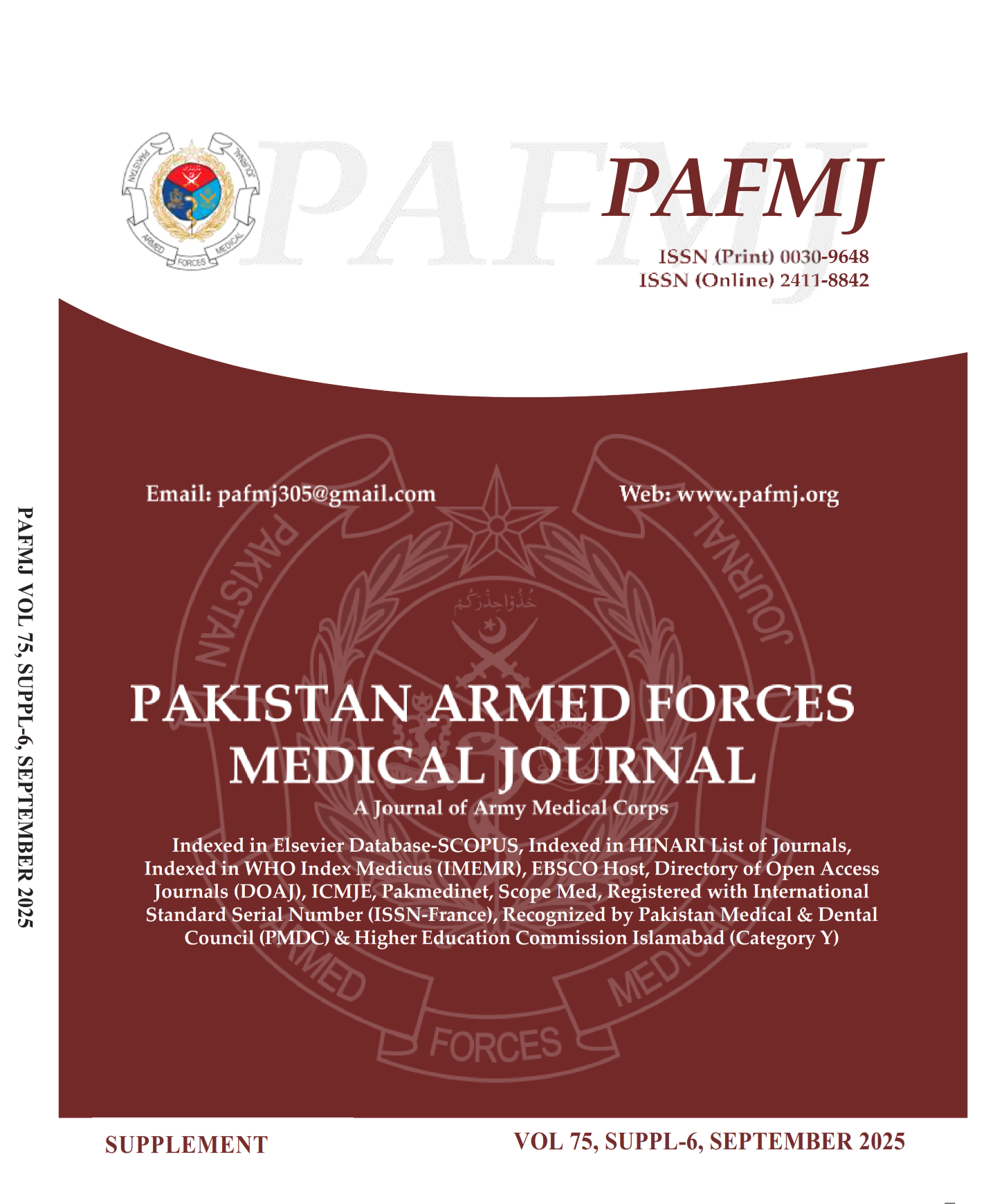Outcome of Conservatively Managed Supra-Tentorial Extradural Hematoma with and Without Linear Fracture In Pediatric Population
DOI:
https://doi.org/10.51253/pafmj.v75iSUPPL-6.9219Keywords:
Linear fracture; Outcome; Pediatric patients; Supra-tentorial extradural hematomaAbstract
Objective: To compare the outcome of conservatively managed supra-tentorial extradural hematoma in pediatric patients with and without linear fracture
Study Design: Comparative cross-sectional study
Place and Duration of Study: Neurosurgery Department, Ayub Teaching hospital Abbottabad. September 2020 to May 2022
Methodology: A total 200 children with confirmed diagnosis of supra-tentorial extradural hematoma who were managed conservatively in our neurosurgery unit during the study period were included in the analysis. They were divided into two groups on the basis of presence of linear skull fracture and both the groups were observed closely by clinical team for 48 hours. Increase in size of hematoma, drop in Glasgow coma scale score, critical care unit admission and requirement of surgical excision within 48 hours were the parameters compared in both groups.
Results: Out of 200 children included in the study, 127(63.5%) were male while 73(36.5%) were female. Mean age of the study participants was 7.4 6±5.65 years. 138(69%) had linear fracture along with extradural hematoma while 62(31%) had no linear fracture. Statistical analysis revealed that outcome parameters like increase in size of hematoma, drop in Glasgow coma scale score and requirement of surgical excision were found more in patients who had no linear fracture as compared to those who had extradural hematoma and linear fracture (p-value<0.05).
Conclusion: Conservative management was seen more successful in patients with linear fracture as compared to those who had no linear fracture along with extradural hematoma in terms of increase in size of hematoma, drop in Glasgow coma ...
Downloads
References
1. Yadollahi M. A study of mortality risk factors among trauma referrals to trauma center, Shiraz, Iran, 2017. Chin J Traumatol. 2019; 22(4): 212-218.
https://doi:10.1016/j.cjtee.2019.01.012
2. Crupi R, Cordaro M, Cuzzocrea S, Impellizzeri D. Management of Traumatic Brain Injury: From Present to Future. Antioxidants (Basel). 2020; 9(4): 297. Published 2020 Apr 2.
https://doi:10.3390/antiox9040297
3. Alihonou T, Quenum K, Padonou A, Amossou F, Dossou F. Neurosurgical Emergencies at a Tertiary Referral Center in a Sub-Saharan African Country. J Neurosci Rural Pract. 2020; 11(3): 407-410.
https://doi:10.1055/s-0040-1709354
4. Yatsushige H. Surgical Management of a Post-traumatic Intracranial Hematoma. No Shinkei Geka. 2021 ; 49(5): 977-985. Japanese.
https://doi: 10.11477/mf.1436204480.
5. Lee JJ, Segar DJ, Morrison JF, Mangham WM, Lee S, Asaad WF. Subdural hematoma as a major determinant of short-term outcomes in traumatic brain injury. J Neurosurg. 2018; 128(1): 236-249.
https://doi: 10.3171/2016.5.JNS16255.
6. Shin DS, Hwang SC. Neurocritical Management of Traumatic Acute Subdural Hematomas. Korean J Neurotrauma. 2020; 16(2): 113-125. Published 2020 Oct 26.
https://doi:10.13004/kjnt.2020.16.e43
7. Spazzapan P, Krašovec K, Velnar T. Risk factors for bad outcome in pediatric epidural hematomas: a systemic review. Chin Neurosurg J. 2019; 5: 19. Published 2019 Aug 8.
https://doi:10.1186/s41016-019-0167-6
8. Al-Mamoori MJ. Management of epidural hematoma in the pediatric age group. Med J Babylon. 2022 ; 16(3): 276-85
9. Umerani MS, Abbas A, Aziz F, Shahid R, Ali F, Rizvi RK. Pediatric Extradural Hematoma: Clinical Assessment Using King's Outcome Scale for Childhood Head Injury. Asian J Neurosurg. 2018; 13(3): 681-684.
https://doi:10.4103/ajns.AJNS_164_16
10. Ammad ul Haq M, Abbas G, Ali A, Hamid M, Ahmed D, Javed S et al. Frequency of Extradural Hematoma in Patients with Skull Fracture after Head Injury. Pak J Neurol Surg. 2021; 25(1): 49-56.
11. Aurangzeb A, Ahmed E, Afridi EA, Khan SA, Muhammad G, Ihsan A et al. FREQUENCY OF EXTRADURAL HAEMATOMA IN PATIENTS WITH LINEAR SKULL FRACTURE. J Ayub Med Coll Abbottabad. 2015; 27(2): 314-317.
12. Al-Zekri M, Assoumane I, Bachir S, Handis C, Khelifa A, Morsli A. Supra- and infra-tentorial subacute extradural hematoma. Chin J Traumatol. 2020; 23(2): 122-124.
https://doi:10.1016/j.cjtee.2019.09.001
13. Dehbozorgi A, Mousavi-Roknabadi RS, Hosseini-Marvast SR, Sharifi M, Sadegh R, S, Farahmand F et al. Diagnosing skull fracture in children with closed head injury using point-of-care ultrasound vs. computed tomography scan [published correction appears in Eur J Pediatr. 2020 Nov 19;:]. Eur J Pediatr. 2021; 180(2): 477-484.
https://doi:10.1007/s00431-020-03851-w
14. Yamal JM, Hannay HJ, Gopinath S, Aisiku IP, Benoit JS, Robertson CS. Glasgow Outcome Scale Measures and Impact on Analysis and Results of a Randomized Clinical Trial of Severe Traumatic Brain Injury. J Neurotrauma. 2019; 36(17): 2484-2492.
https://doi: 10.1089/neu.2018.5939.
15. Aji YK, Apriawan T, Bajamal AH. Traumatic Supra- and Infra-tentorial Extradural Hematoma: Case Series and Literature Review. Asian J Neurosurg. 2018; 13(2): 453-457. https://doi:10.4103/ajns.AJNS_282_16
16. Zwayed ARH, Lucke-Wold B. Conservative management of extradural hematoma: A report of sixty-two cases. Neurol Clin Neurosci. 2018; 2(2): 5-9.
17. Kandregula S, Sadashiva N, Konar S, et al. Surgical management of traumatic extradural hematomas in children: an analysis of 201 patients at a tertiary neurosurgical center. Childs Nerv Syst. 2019; 35(5): 807-813.
https://doi:10.1007/s00381-019-04088-1
18. Traiq M, Mian MA, Ali M, Ayub S, Khan WD et al. Outcome of the Traumatic Extradural Hematoma on the Basis of Size of Extradural Hematoma. Pak J of Neurol Surg. 2021; 25 (2): 134-142
Downloads
Published
Issue
Section
License
Copyright (c) 2025 Zainab Manan, Meena Hayat, Abdul Aziz Khan, Shafique-ur- Rehman, Ehtisham Ahmed Khan Afridi, Idrees Ahmed

This work is licensed under a Creative Commons Attribution-NonCommercial 4.0 International License.















